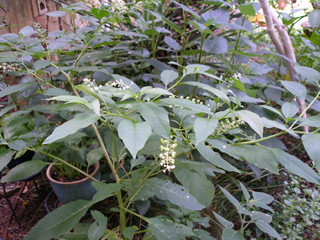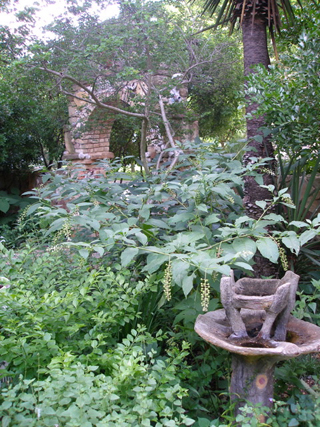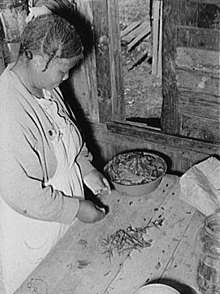Human Flower Project
Friday, July 13, 2007
Botanical Gentry, Make Room for Pokeweed
As the unruly “salat” maker vies for space in her garden, horticulturist and garden designer Jill Nokes puts in a good word for a disparaged plant. Jill, we and the mockingbirds thank you!

Pokeweed in flower, Austin, TX, July 2007
Photo: Jill Nokes
By Jill Nokes
Around here, the summer of ’07 will surely be remembered for freakishly abundant rainfall. It’s already mid-July, yet my garden looks more like Vietnam’s Mekong Delta than Central Texas. But after two years of scary drought conditions, I’m not complaining. Even ordinary plants are super-sized and showing off, hoping to get a full-time gig in the permanent display. I’m especially enjoying a bumper crop of pokeweed (Phytolacca Americana var. Americana).
 Pokeweed
Pokeweed
Phytolacca Americana var. Americana
Photo: Jill Nokes
Pokeberry and elderberry are among the plants that fall into the red-headed stepchild category: they are interesting, and even useful, but for most people they are just too unruly or free-spirited to mingle well with the botanical gentry. Horticultural literature in general disdains them and insists that every serious gardener must learn to separate the sheep from the goats when making plant selections. But, I wonder, why must it be an either/or proposition? Many rejected plants are well suited for remnant, overlooked and underused areas in the yard, like alleys or the narrow space between a garage and fence, where the trash cans are kept. There, they can grow freely and be enjoyed for what they are.
Pokeweed (also called pokeberry) is a large-leaved branching plant with reddish stems and long clusters of small white flowers that develop into dark purple-black fruits. It freezes back to a perennial rootstock, and also enlists avian assistance in seed dissemination. As with other berry-producing plants such as chile pequin, lantana, and possum-haw holly, mockingbirds are crazy about the fruit. Recently I read that the population of many common songbirds was dropping, so I believe I’ll leave those extra plants where they are for now.
 Preparing poke salad
Preparing poke salad
near Marshall, TX, c. 1930
Photo: via answers.com
Folklore tells us that pokeweed or poke salad, like early spring dandelion and chicory, was a welcome addition to a pioneers’ winter-weary salt pork diet, though one is warned to boil only the young greens from shoots no longer than six inches long, before the stems turn crimson, because the older plant has toxic properties. You must “throw off” the boiling water twice before eating. One of pokeweeds “reputed virtues” is as a cathartic—I believe I’ll leave the taste testing to my mockingbirds.
Someone once told me that during the Civil War, soldiers used the purple stain from the fruit as an ink substitute. I wonder if those pokeweed letters are still legible, or if they have faded into the ground like the plant itself after the first frost. Pokeweed’s range is so widespread, that I like to imagine hungry and lonesome soldiers happy to recognize it as they were bivouacked in temperate forests far from home.




